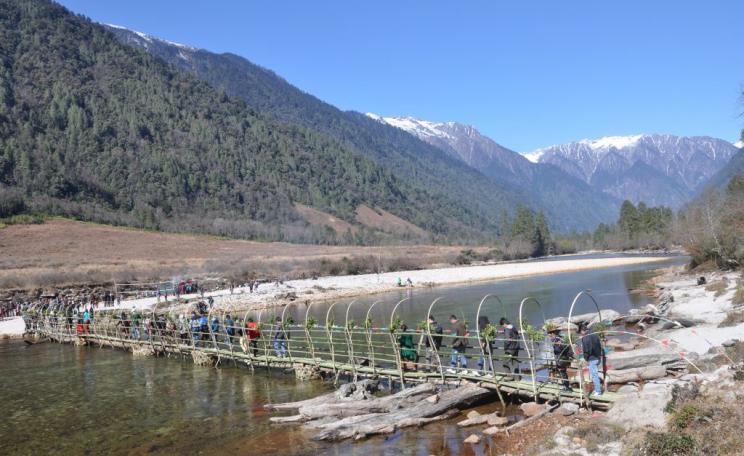Coal produced to support overall economic growth generates environmental injustices and is inherently linked to land dispossession, appropriation of livelihoods, and water and air pollution.
Climate change affects countries, regions, and communities disproportionately. Places and populations already socio-economically vulnerable are set to bear the brunt of the global heating world.
In the Indian context, recent research demonstrates that 75 percent of Indian districts are vulnerable to extreme climate events. India’s performance at international climate negotiations suggests it is well aware of the consequences of climate change.
The Indian Government pledged to generate about 40 percent of electricity from non-fossil sources by 2030 during the 2015 UN Climate Change Conference in Paris (COP21). However, despite talks of renewable energy and the need for an energy transition, coal is on the rise in India and the country is in the process of deepening its ties to fossil energy carriers rather than moving away from this type of energy use.
Industry
India is now on the path to extract one billion tons of coal annually by 2023-24. Already, auctions for coal mining concessions to private companies have been launched for 41 coal blocks in the country, including in regions of rich biodiversity and ancient forests inhabited by indigenous communities.
This is in addition to further plans to auction another 55 concessions for new coal mines and expanding at least 193 current mines in the next five years. In 2017, India was the second largest producer and importer of coal in the world.
Coal is needed, the argument goes, for development: the expansion of industries and services for economic growth and employment, improved access to electricity, and clean cooking fuel for those considered to be “energy poor”—even though the largest and fastest-growing consumer of Indian electricity is industry at approximately 40 percent, compared to less than 25 percent for households (with vast inequalities within household consumption).
This was the rationale behind the decision for commercial auctions for the coal mining of 41 blocks earlier this year. During the launch, several benefits, such as the creation of 2.8 lakhs jobs and the generation of Rs. 20,000-crore in revenues, were listed.
Coal produced to support overall economic growth generates environmental injustices and is inherently linked to land dispossession, appropriation of livelihoods, and water and air pollution.
However, a Right to Information (RTI) request seeking the reports or calculations based upon which these data were generated by author and energy researcher Sandeep Pai was initially responded to with no data to back the claim. Upon further questioning, he received supplementary information not through official communication, but on Twitter. This shows how the claims for employment and revenue generation are made without a concrete methodology, and, thus, can be easily disputed.
Extraction
At the same time, what can’t be disputed is the enormous social and environmental cost that the entire supply chain of coal generates.
From extraction to transportation and combustion, coal is a contested resource and a commodity that does not address India’s interlinked socio-ecological challenges of poverty (both economic and energetic) and unemployment, environmental degradation, and the climate crisis.
Coal produced to support overall economic growth generates environmental injustices and is inherently linked to land dispossession, appropriation of livelihoods, and water and air pollution.
For populations living around coal-fired power plants, premature mortality ranges from 80,000 to 115,000 premature deaths per year. Coal mine workers and communities around coal mines face many adverse diseases, prominent among them pneumoconiosis (commonly known as black lung disease) due to the inhalation of coal dust, as well as diseases due to polluted drinking water.
As a result, coal is a heavily contested resource, the subject of protests and conflicts across the country. These conflicts are a part of a broader environmental justice movement in India, claiming autonomy and socio-ecological well-being in the face of the country’s growth trajectory without adequately addressing concerns for the people and the planet.
Protests
Many of these protests against coal last for decades. One such conflict, in the district of Hazaribagh, in the eastern Indian state of Jharkhand, has been ongoing since 2004, due to its adverse impacts not only on its biodiverse forests and agricultural land but also the prehistoric megaliths discovered in the region.
Local villagers, many of them Adivasis, organized to protest the land appropriation for the sake of mining. Since 2004, the Committee for the Struggle to Save Karanpura has been protecting farmland against India’s largest coal company’s (NTPC Limited) coal mining ambitions, organizing a number of marches and demonstrations.
Amidst protests, and with heavy security, however, mining commenced on May 17, 2016 in the region. Other recent protests include movements against turning Goa into a coal hub, which has garnered much media attention.
Earlier this year, the movement to stop coal mining in the Dehing Patkai wildlife sanctuary in Assam also saw active online mobilization amidst the Covid-19 crisis.
Phase-out
For India to remain true to its climate goals and mitigate the intense effects of climate change in the country, a true coal phase-out is urgently needed. Such a phase-out, however, has to involve two things that are absent from the Indian government’s current plan.
First, the government must leave the “coal in the hole,” halt extraction even while it is still considered “economically viable,” and end India’s tryst with coal.
Second, a tremendous joint endeavor of people, government, and businesses are needed to transform the energy system not only from one based on fossil fuels and nuclear energy to one based on renewables, but also from a heavily capitalized, centralized system to one that is locally controllable with decentralized energy provisioning.
The expansion of the Indian coal complex is troubling because of the present and expected contribution to the climate crisis. The threat to human livelihoods and human lives is devastating, which is why we see such fierce resistance from locals protesting this expansion. But what is so violently enforced in all these cases is the dominance of the interests of powerful actors over the local populations.
As temperatures continue to rise, and heatwaves and air pollution continue to plague India’s citizens, the country has the ability to move to more sustainable forms of energy and away from the fossil system, a system which is neither sustainable nor just.
This Author
Brototi Roy is a part of the EnvJustice team at Institute of Environmental Science and Technology, Autonomous University of Barcelona. Her PhD is focussed on environmental justice movements against coal in India using the frameworks of ecological economics and political ecology. She is also an elected executive committee member of the Indian Society for Ecological Economics.
This research article is based on a co-authored paper with Anke Schaffartzik, published in the February 2021 issue of Ecological Economics and can be read here. This article was originally published at the University of Pennsylvania's Center for the Advanced Studies of India (CASI).






